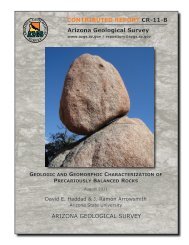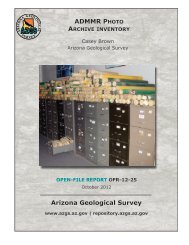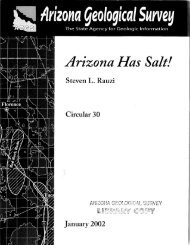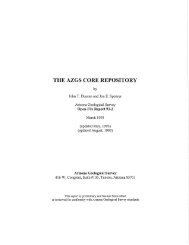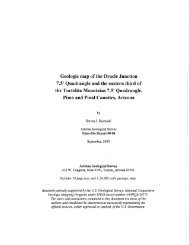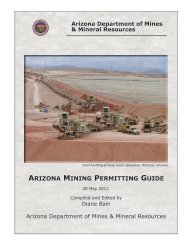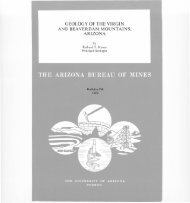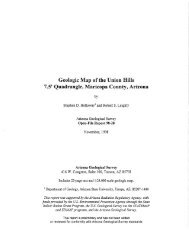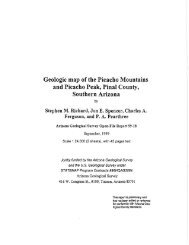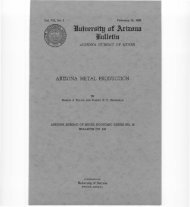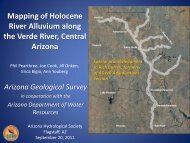Subsurface Geologic Investigation of Fountain Hills - AZGS ...
Subsurface Geologic Investigation of Fountain Hills - AZGS ...
Subsurface Geologic Investigation of Fountain Hills - AZGS ...
You also want an ePaper? Increase the reach of your titles
YUMPU automatically turns print PDFs into web optimized ePapers that Google loves.
Padgett (1945) discussed two water wells penetrating "water-bearing conglomerates"<br />
beneath the clay, close to the center <strong>of</strong> the valley. One well, drilled 540 feet deep in the<br />
central part <strong>of</strong> the valley, was artesian and "had sufficient pressure to flow at the<br />
surface." Recently, wells drilled for the FHSD have also demonstrated confined aquifer<br />
conditions (HSI, 2002a and 2002b). These wells drilled and constructed in the regional<br />
aquifer system exhibit water level elevations occurring at approximately 1,340 feet above<br />
mean sea level (amsl).<br />
The central part <strong>of</strong> the valley, from the Town <strong>of</strong> <strong>Fountain</strong> <strong>Hills</strong> to just south <strong>of</strong><br />
Needle Rock, is underlain by as much as 500 feet <strong>of</strong> fine-grained silt and clay deposits <strong>of</strong><br />
the Pemberton Ranch Formation. The unit is nearly flat-lying and undeformed. Surface<br />
exposures are weakly consolidated and hence do not exhibit a pervasive network <strong>of</strong><br />
fractures that might act as conduits for recharge. This unit is effectively an aquiclude and<br />
little if any groundwater recharge would be expected to occur through this unit in the<br />
central part <strong>of</strong> the basin. The bedrock areas in the north, between Needle Rock and<br />
Bartlett Dam, may be logical recharge sites. Older, grussy sandstone and conglomerate<br />
(map unit Tc) are overlain by basalt flows (map unit Tb), which are in tum overlain by<br />
conglomerates <strong>of</strong> the Needle Rock Formation (map unit Tsn). The grussy sandstones are<br />
moderately to weakly consolidated and are relatively permeable, but their distribution on<br />
the surface near the river is minor and most exposures are buried beneath basalt flows.<br />
The basalt is dense and impermeable, but most outcrops are highly fractured and these<br />
fractures may provide enough permeability to allow recharge in this area. The overlying<br />
Needle Rock Formation is mostly strongly cemented by coarse-grained calcite spar and<br />
probably is not very permeable. However, the Needle Rock Formation is also locally<br />
fractured. So although the rock types exposed along the Verde River in the north are not<br />
highly permeable, fractures may allow for some recharge. More data on fracture<br />
permeability needs to be acquired before firm conclusions can be reached about recharge<br />
occurring in the north.<br />
Mountain front recharge is a significant source <strong>of</strong> water in the <strong>Fountain</strong> <strong>Hills</strong> sub<br />
basin, and has been estimated to be approximately 2,700 acre-feet per year (excluding<br />
Sycamore Creek) (HSI, 2002c). Mountain front recharge by definition is the water that<br />
infiltrates into the zone <strong>of</strong> coarse alluvium that extends from the base <strong>of</strong> the mountain<br />
17



